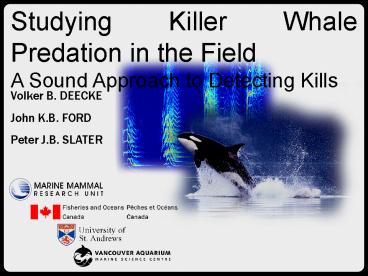Studying Killer Whale Predation in the Field PowerPoint PPT Presentation
1 / 12
Title: Studying Killer Whale Predation in the Field
1
Studying Killer Whale Predation in the Field A
Sound Approach to Detecting Kills
Volker B. DEECKE John K.B. FORD Peter J.B. SLATER
2
BACKGROUND Killer whales in the North Pacific
ecosystem
- Delineating the ecological role of mammal-eating
killer whales requires precise knowledge about
their abundance, dietary preferences, and the
frequency of predation events
- Rates of killer whale prey consump-tion are
usually extrapolated from estimates of metabolic
requirements.
- Field data on predation rates for this area are
currently limited
3
BACKGROUND Detecting killer whale predation in
the field
- Predation on some species can be very subtle and
some kills may be missed using visual
observations alone. This may bias data on prey
preference and predation rates
?OBJECTIVE to test whether monitoring killer
whale sound production can help to detect
predation events
4
Data Collection
- We recorded underwater sound production near
groups of killer whales in Southeast Alaska
- We documented any predatory behaviour and
collected prey remains whenever possible
- We measured the distance to the animals using
laser rangefinders
- We counted the number of sounds produced while
the animals were within 500m of the boat
5
Acoustic Detection of Kills Pulsed Calls
?mammal-eating killer whales consistently emit
pulsed calls after a kill and these are good
indicators of predatory activity.
6
Acoustic Detection of Kills Whistles
?whistles are only produced rarely and are not
consistently associated with predation events.
7
Acoustic Detection of Kills Echolocation Clicks
?mammal-eating killer whales typically echolocate
during and after an attack and echolocation
presents a useful tool to detect predation events.
8
Acoustic Detection of Kills Killing, Ramming and
Crushing Sounds
Kruskall-Wallis p 0.028
?KRaCS are generated when killer whales handle a
prey animal or carcass. They may be some of the
best indicators that an attack was successful.
9
Estimating Predation Rates Preliminary results
- In the years 2003-2005, we followed 28 groups of
transient killer whales for a total of 115 hrs
while monitoring their sound production.
10
CONCLUSIONS acoustic detection of killer whale
predation
- Pulsed calls and KRaCS are consistently
associated with kills
- Acoustic monitoring presents a powerful tool to
detect killer whale predation in the field
- Relying on surface behaviour alone may lead to
missed predations events and may bias the prey
spectrum towards larger and faster prey that are
more difficult to subdue
Preliminary data suggest that killer whales
consume the equivalent of one harbour seal per
day. Killer whale predation has a significant
potential impact on populations of pinnipeds and
cetaceans in the North Pacific.
11
How do you know that transients have made a kill?
Listen to the whales theyll probably let you
know.
12
SUPPORT IN THE FIELD AND LAB Douglas
Chadwick Michael deRoos Steve
Jeffries Vicky Livaditis Josh
London Allyson Miscampbell Patrick Presi
COLLABORATORS Lance G. Barrett-Lennard Graeme
M. Ellis Craig O. Matkin Dena R.
Matkin Jan M. Straley
LOGISTIC SUPPORT Alaska Marine Lines Glacier
Bay National Park Preserve The Communities of
Gustavus, Juneau, and Petersburg
THANKS TO

